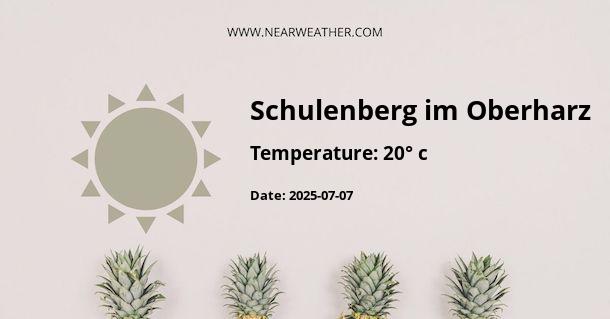Understanding the Climate and Weather Patterns of Schulenberg im Oberharz, Germany
Located in the Upper Harz region of Lower Saxony, Germany, Schulenberg im Oberharz is a destination known for its picturesque landscapes and a climate that is heavily influenced by its mountainous terrain. In this comprehensive examination of the area's climate and weather, we delve into the various factors that define Schulenberg im Oberharz's unique weather patterns throughout the year.
Geographical Influences on Schulenberg im Oberharz's Climate
The local climate of Schulenberg im Oberharz is predominantly determined by its altitude and topographical placement within the Harz Mountains. The area is classified as having an Oceanic climate (Cfb) under the Köppen climate classification, but with a sub-alpine character due to its high elevation. This translates to cool summers, cold winters, and precipitation distributed fairly evenly throughout the year. Moreover, the Harz Mountains act as a barrier, causing higher precipitation levels as air masses are forced to ascend, cooling and leading to orographic rainfall.
Temperature Overview
The average annual temperature in Schulenberg im Oberharz is relatively low, considering its northern European location. Typically, this region would experience a mean annual temperature ranging between 4°C and 7°C (39°F to 45°F), indicating a colder climate relative to areas at lower altitudes and further from the mountain sources of inclement weather.
Seasonal Temperature Breakdown
- Spring: The spring season, from March to May, sees gradual warming. Despite this, frosts can persist well into April, and temperatures average from 0°C to 10°C (32°F to 50°F).
- Summer: June through August marks the summer period, with temperatures that are mild but rarely excessive, averaging 10°C to 20°C (50°F to 68°F). It is the warmest time of the year, yet still considerably cooler than what would be expected in regions outside of the Upper Harz.
- Autumn: Temperatures start to decrease throughout September to November, ranging from 3°C to 15°C (37°F to 59°F). First frosts usually appear towards the end of this season, indicating the approaching winter.
- Winter: December through February is characterized by cold temperatures that commonly fall below freezing. The average temperatures are between -3°C to 2°C (27°F to 36°F), and snowfall is a regular occurrence, making it a popular season for winter sports enthusiasts.
Precipitation Patterns
Given its mountainous landscape, Schulenberg im Oberharz experiences steady precipitation throughout the year, influenced by its orographic conditions. On average, the region receives approximately 1300 to 1600 millimeters (51 to 63 inches) of precipitation annually.
Monthly Rainfall
| Month | Average Precipitation (mm) | Average Precipitation (inches) |
|---|---|---|
| January | 100 | 3.9 |
| February | 80 | 3.1 |
| March | 90 | 3.5 |
| April | 70 | 2.8 |
| May | 80 | 3.1 |
| June | 100 | 3.9 |
| July | 110 | 4.3 |
| August | 100 | 3.9 |
| September | 90 | 3.5 |
| October | 80 | 3.1 |
| November | 100 | 3.9 |
| December | 110 | 4.3 |
It is crucial to note that there is significant snowfall in the winter months, which contributes to the precipitation totals measured in the form of snow rather than rain.
Extreme Weather and Climate Events
While Schulenberg im Oberharz is not known for extreme weather events such as tornadoes or hurricanes, it is not entirely free from hazardous weather conditions. Heavy snowfall can lead to avalanche risks in the surrounding mountains, and the area can experience heavy fog, particularly in the transitional periods of spring and autumn.
Sunlight and Daylight Hours
The position of Schulenberg im Oberharz in northern Germany means that it experiences significant variation in daylight hours throughout the year. The longest day is in the summer solstice in June when daylight can last for up to 16 hours, while the shortest day occurs at the winter solstice in December with only around 8 hours of daylight.
Wind Patterns
The wind in Schulenberg im Oberharz tends to be moderate, with average speeds typically not exceeding 3.5 to 5.5 meters per second (8 to 12 miles per hour). The area's topography significantly influences local wind patterns, leading to often unpredictable wind gusts particularly in the higher altitudes or exposed areas.
Recommended Activities Based on Climate
- Winter Sports: The region is famous for its winter sports opportunities, including skiing and snowboarding, with optimal conditions typically from December through March.
- Hiking: Late spring to early autumn is the best time for hiking to avoid the harsher winter conditions and snow-covered trails.
- Cultural Tours: For visiting historical towns and cultural sites in Schulenberg im Oberharz, the milder weather of late spring through early autumn is ideal.
Advisory and Preparatory Measures
Visitors to Schulenberg im Oberharz should prepare for varying weather conditions depending on the season. Warm clothing and waterproof gear are essential for the majority of the year, especially when engaging in outdoor activities. It is also recommended to stay updated with the local weather forecasts to anticipate sudden weather changes that may impact travel and outdoor plans.
Conclusion
With its distinct climatic features shaped by the Upper Harz Mountain's topography, Schulenberg im Oberharz presents a fascinating case for weather and climate enthusiasts. Understanding the area's meteorological nuances is not only of academic interest but serves as a practical guide for locals, tourists, and businesses alike. As climate patterns evolve globally, ongoing monitoring and research will continue to refine our grasp of this region's complex weather dynamics.
A - Schulenberg im Oberharz's Latitude is 51.833328 & Longitude is 10.433330.
A - Weather in Schulenberg im Oberharz is 9° today.
A - Climate Conditions in Schulenberg im Oberharz shows overcast clouds today.
A - Humidity in Schulenberg im Oberharz is 89% today.
A - Wind speed in Schulenberg im Oberharz is 24.16 km/h, flowing at 222° wind direction. today.
